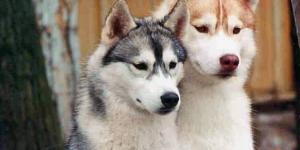How Much Shedding Is Normal for a Dog?

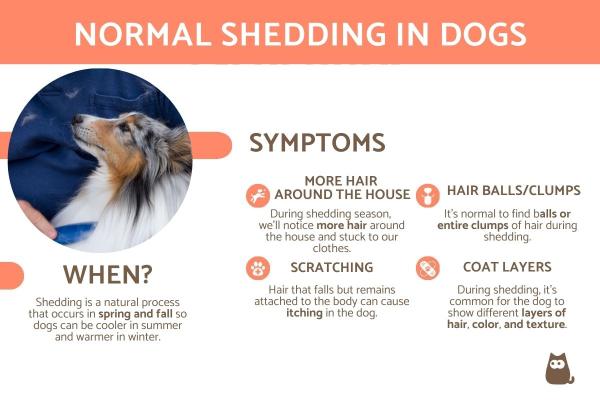
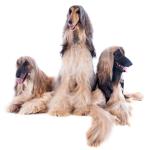
See files for Dogs
Got dog hair on everything you own? Join the club. Ask any dog owner about shedding, and you'll likely get an eye roll followed by a resigned sigh. It's just part of the deal when you bring a dog into your life. However, understanding the difference between typical canine hair fall and excessive shedding that might signal an underlying issue is crucial for your peace of mind and your dog's well-being.
This AnimalWised article will explain dog shedding, including what is considered normal and what to expect regarding its timing and duration.
Why do dogs shed?
Hair loss in dogs isn't a malfunction, it's actually your dog's body working exactly as designed. Dogs naturally replace old or damaged fur with fresh growth throughout their lives. Most dogs shed more heavily during specific seasons as their bodies adapt to changing temperatures and daylight hours.
Hormones actually choreograph this whole process. When daylight hours change with the seasons, your dog's brain produces different levels of hormones (melatonin) which directly signals to hair follicles that it's time to start shedding. This is why artificial lighting in homes can sometimes confuse your dog's natural shedding process.
This process serves several key purposes:
- It helps dogs cool down when warm weather arrives.
- It allows for thicker insulation when temperatures drop.
- It removes damaged or dead hair.
- It keeps their skin and coat in healthy condition.
Country dogs and working breeds often follow clearer seasonal patterns. They'll "blow their coat" dramatically in spring and fall.
Your average house dog, on the other hand, might shed year-round since they're lounging in your climate-controlled living room rather than responding to natural seasonal cues.
Your dog's age plays a role too. Puppies go through a special one-time "puppy coat" that they shed at around 4–6 months of age, when that soft initial fur gets replaced by their adult coat. This isn't the same as seasonal shedding, it's a developmental milestone. Not only that, but senior dogs also experience changes in coat quality and shedding patterns as their hormones and metabolism shift with age.
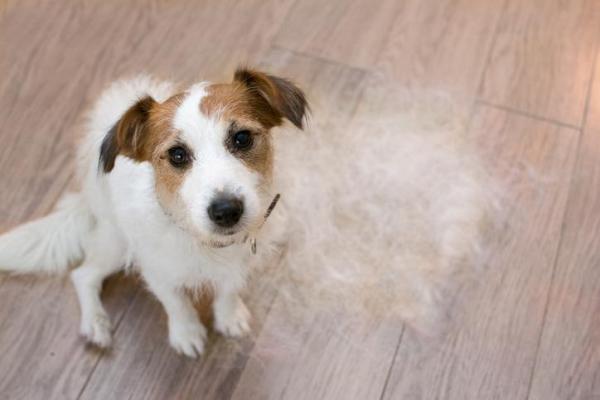
What month do dogs shed the most?
Shedding doesn't happen randomly. In fact, most dogs follow predictable patterns:
Spring coat blow: (March-May)
As temperatures warm up, you'll notice your dog dumping their winter layers. This spring shed can transform your home overnight. One day your dog looks normal, the next they're surrounded by tufts of undercoat coming loose in clumps. During spring shedding, you'll spot:
- Hair, everywhere.
- Visible tufts that you can gently pull from your dog's coat.
- A lighter, sleeker coat emerging underneath all that fluff.
Fall coat Preparation: (September-November)
Fall shedding doesn't always get as much attention as the spring version, but it definitely happens. As days shorten and temperatures cool, dogs shed their summer coats to make room for thicker winter protection.
How long does dog hair shedding last?
The good news is that seasonal shedding doesn't last forever. Most healthy dogs complete their seasonal coat transitions within 2-4 weeks, though this timeframe stretches longer for some breeds, especially those with thick undercoats. Northern breeds like Huskies can sometimes take up to six weeks to fully shed their winter layers in spring.
To learn which breeds naturally shed more than others, take a look at our other article on high-shedding dog breeds.
What does normal shedding look like?
Not all shedding is created equal. When your dog is going through regular, healthy shedding, you'll notice the fur comes out fairly evenly across the body. There will naturally be some increase in loose hair around the house, particularly during seasonal transitions.
With double-coated breeds, you'll often see visible tufts or small clumps as the undercoat releases. The occasional scratch is normal too, as loose fur can create mild itchiness as it detaches. You might also notice coat color or texture changes as new fur grows in.
Concerning hair loss typically shows specific patterns that make it different from normal shedding:
- Bald spots or patches where skin is visible.
- Redness, inflammation, or other skin issues.
- Obsessive scratching, licking, or biting at certain areas.
- Sudden, dramatic increase in shedding outside normal seasonal timing.
- Dull, brittle fur or poor-quality regrowth.
- Other symptoms like lethargy, appetite changes, or behavior shifts.
If something seems off about your dog's shedding pattern, it's worth consulting with your veterinarian. Unusual shedding patterns often signal underlying issues that benefit from professional assessment. Many skin and coat problems are much easier to address when caught early.
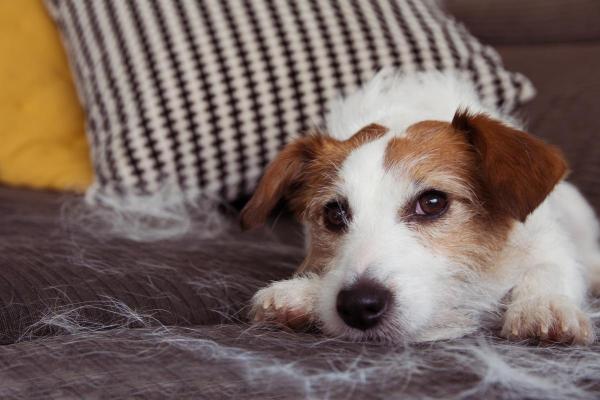
Why is my dog suddenly shedding like crazy?
If you've noticed your vacuum cleaner filling up faster than usual, you're probably wondering what triggered the sudden fur explosion. While some shedding is normal, dramatic increases often have specific causes:
- Seasonal intensity varies from dog to dog: some barely show seasonal changes while others transform your home into what looks like a stuffed animal factory exploded. That spring shed can be particularly shocking if you're a first-time owner of a double-coated breed.
- Stress and big changes can trigger emotional shedding: moving homes, adding new family members (human or animal), or changes in routine can cause temporary shedding increases. Dogs are creatures of habit, and their bodies often react to disruption with a wave of hair loss. Even something as seemingly minor as rearranging furniture can stress sensitive dogs enough to increase shedding.
- Sudden diet changes: especially switching to lower quality food, can show up as increased shedding within just a couple weeks. Your dog's follicles are surprisingly responsive to nutritional shifts. They're essentially little factories that need proper raw materials to function optimally.
- Temperature fluctuations: especially those beyond the normal seasonal shifts can confuse your dog's coat. A week of unusually warm weather in winter or a cool spell in summer might trigger an unscheduled mini-shed as your dog's body tries to adapt.
As mentioned earlier, health issues that cause excessive shedding tend to create distinctive patterns. These patterns typically signal something beyond normal shedding and warrant a conversation with your vet.
For readers who struggle with pet allergies but love dogs, we've compiled information on breeds that may be more compatible with sensitive immune systems.
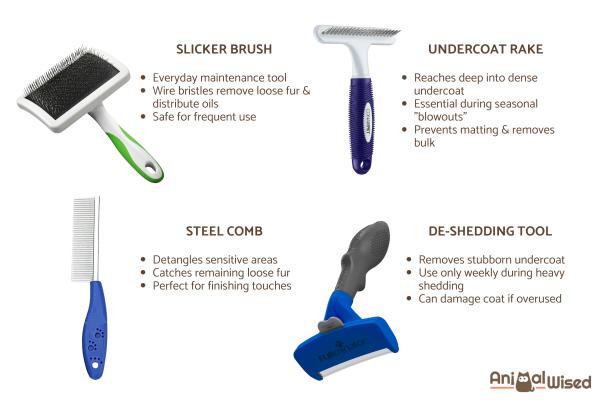
How does a dog's coat type affect shedding?
Dogs have evolved a wide variety of coat types, each with its own shedding pattern and grooming needs. Understanding what you're working with makes all the difference between fighting a losing battle and managing shedding effectively.
Short coat:
Boxers, Dobermans, and Dalmatians have these sleek, close-lying coats that feel almost velvety to touch. Don't be fooled by their minimalist appearance, these dogs can shed plenty. Their stiff, short hairs have a talent for embedding themselves into fabrics like tiny darts. You've probably noticed them sticking to your clothes and requiring more than a casual brush-off to remove.
These dogs benefit from weekly rubdowns with a rubber curry brush or grooming mitt. The short bristles grab loose hairs before they end up on your furniture. Since their coats don't tangle, grooming is thankfully straightforward, just consistent.
Double-coat:
German Shepherds, Huskies, and Labradors come equipped with nature's perfect insulation system. A soft, dense undercoat protected by a weather-resistant topcoat. This dual-layer system explains why these breeds seem to shed exponentially more than others.
During seasonal changes, they "blow" their undercoats. For these fur factories, an undercoat rake is your best alternative. These specialized tools reach through the topcoat to grab loose undercoat without damaging the protective outer layer.
During heavy shedding periods, daily brushing it's necessary.
Medium-length coat:
Cocker Spaniels, Australian Shepherds, and similar breeds have that perfect middle-ground coat that is not too short, not too long. Their fur combines elements of both smooth and long coats, with a moderately dense undercoat protected by a mid-length topcoat.
These breeds tend toward moderate but steady shedding, with noticeable seasonal increases. They require a bit more grooming attention than short-coated breeds because their longer outer coat can trap shedding undercoat, creating mats if neglected.
A slicker brush followed by a metal comb works wonders here. The slicker removes loose undercoat while the comb catches any remaining tangles. Pay special attention to "friction areas" behind ears and under legs, where mats commonly form.
Long coat:
Afghan Hounds, Border Collies, and Newfoundlands have flowing locks that turn heads at dog parks. Their dense undercoat is protected by a topcoat that varies in length across the body.
Their shed hair often gets caught in the surrounding coat rather than immediately dropping onto your floor, creating the illusion that they shed less. However, you'll uncover just how much loose fur they've been secretly carrying around as you brush them.
These coats demand regular maintenance with pin brushes and combs to prevent painful mats. Line brushing is particularly effective. Many owners of long-coated breeds schedule professional grooming every 6-8 weeks to maintain coat health.
Curly coat:
Poodles, Bichon Frise, and Portuguese Water Dogs have curls or waves that grow continuously rather than shedding seasonally. Their coats have minimal undercoat, which dramatically reduces visible shedding.
These breeds are often marketed as "non-shedding" or "hypoallergenic," which isn't entirely accurate. They do lose hair, it just gets caught in their curls instead of falling on your floor. Without regular grooming, those trapped hairs form tight mats that can be uncomfortable and lead to skin problems.
Wide-toothed combs and slicker brushes designed for curly coats help manage these unique coats. Many owners opt for professional grooming every 4-6 weeks to maintain both appearance and comfort.
Wire coats:
Terriers like the Fox Terrier, Irish Terrier, and Schnauzers have rough, bristly outer coats with minimal undercoat. Rather than conventional shedding, wire coats benefit from a process called "hand-stripping" where loose, dead hairs are plucked out periodically. This maintains the proper coarse texture that gives these breeds their weather resistance.
If not hand-stripped, many wire coats will soften over time and lose their appearance. Specialized grooming tools like stripping knives or even just skilled fingers can maintain the proper texture.
Tired of dealing with dog hair everywhere? Discover which breeds naturally shed minimally or hardly at all in our article on low-shedding dogs.
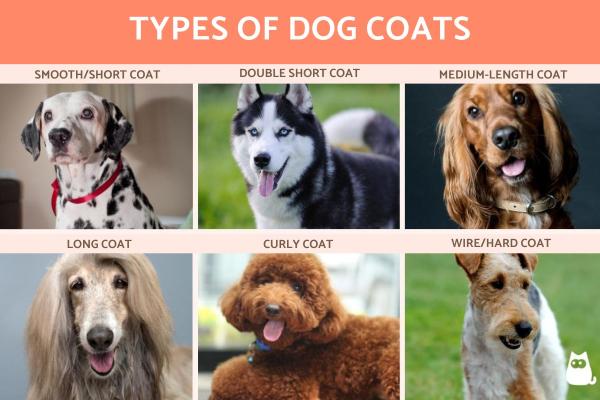
If you want to read similar articles to How Much Shedding Is Normal for a Dog?, we recommend you visit our Fur care category.
- American Kennel Club. (2023, March 14). Dog shedding: What to expect and how to manage it. AKC.org.
- Daigle, J. C. (2023). Coat type and shedding in dogs. Veterinary Partner.
- Nicholas, C. E., Wegienka, G. R., Havstad, S. L., Zoratti, E. M., Ownby, D. R., & Johnson, C. C. (2011). Dog allergen levels in homes with hypoallergenic compared with nonhypoallergenic dogs. American Journal of Rhinology & Allergy, 25(4), 252–256.
- Tufts University Cummings School of Veterinary Medicine. (2021, June 15). The science of shedding: What causes it and how to manage it. Tufts Veterinary Nutrition.

